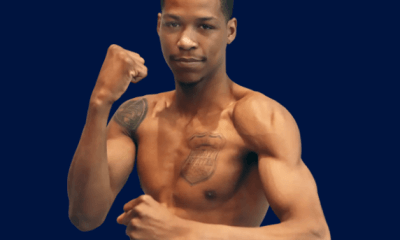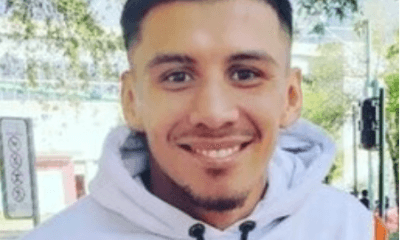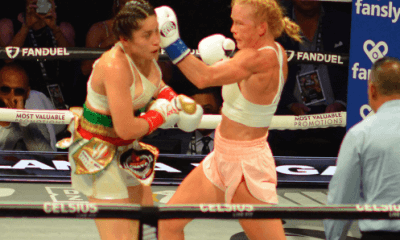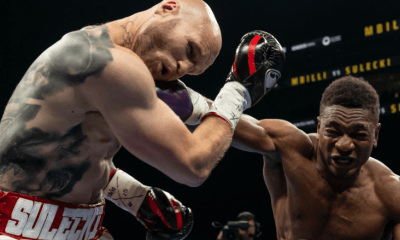Featured Articles
Eleider Alvarez Knew When to Go to the ‘McIntosh’ to Shock Kovalev
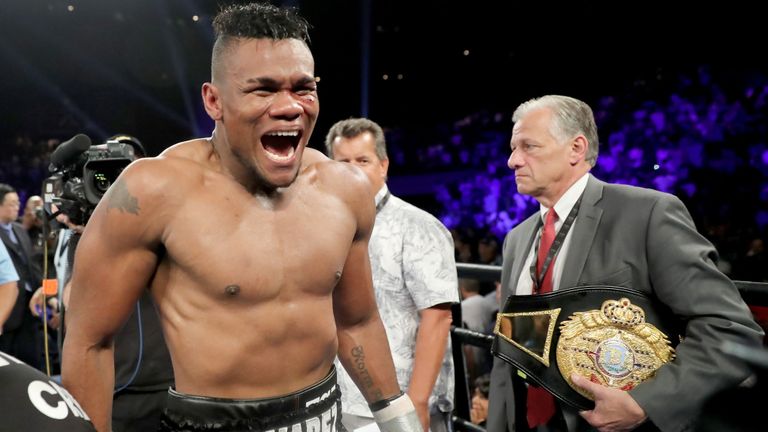
ATLANTIC CITY, N.J. – Until late Saturday night, most people probably knew McIntosh as the Binghampton, N.Y.-based manufacturer of high-end audio equipment. After underdog Eleider Alvarez’s no-doubt-about-it, seventh-round knockout of WBO light heavyweight champion Sergey Kovalev, however, it might also stand for the concussive sound of punches to the jaw, as loud and unmistakable as the riffs of the late, great Keith Moon, the wild ’n’ crazy drummer who helped make The Who one of the best rock bands ever to take the stage.
References to musicians, like Moon, who flashed across the night sky like comets and then vanished into the memories of their fans seem especially appropriate given the venue for Kovalev-Alvarez, the first fight card held at the newly refurbished Hard Rock Hotel & Casino, the former Trump Taj Mahal which shone like a diamond after a $500 million transformation. Gone are the massive chandeliers and India-themed accoutrements that marked its previous incarnation; in are electric guitars and drum kits used by a phalanx of Grammy Award winners who topped the charts for however long they were able to keep their sound fresh and in demand, and their bodies capable of holding up to the demands of a relentless, wearying lifestyle.
After he was sent crashing to the canvas three times in that fateful seventh round, the possibility now appears to be very real that the 35-year-old Kovalev (32-3-1, 28 KOs) may have run out of the kind of smash hits he used to deliver instead of taking. The “Krusher” from Russia now has lost three of his five most recent bouts, including stoppages by Andre Ward and Alvarez, a career slump marked by an alarming tendency to lose energy and power into the middle rounds.
“I think Sergey tends to run out of gas after six rounds,” said Main Events CEO Kathy Duva, Kovalev’s promoter. “That seemed to be the magic round with Ward, too. He did great for six rounds and then faltered. I assume he got tired.”
Although Kovalev has a rematch clause that he and his support team could enforce sooner rather than later, Duva hinted that their guy might be better served to take some time off to consider his options. That could open the door for Colombia-born, Montreal-based Alvarez – finally a star, if only temporarily – to proceed to a unification showdown with another Russian, Dmitry Bivol (14-0, 11 KOs), who retained his WBA 175-pound title with a workmanlike unanimous decision over Isaac Chilemba (25-6-2, 10 KOs) in the first half of the HBO-televised doubleheader. Other holders of alphabet light heavyweight straps are the WBC’s Adonis Stevenson (29-1-1, 24 KOs) and still another Russian, the IBF’s Artur Beterbiev (12-0, 12 KOs).
For his part, Bivol expressed disappointment that countryman Kovalev, a 1-to-6 favorite in Atlantic City’s newly opened sports books, had lost, and not just for reasons of nationalistic pride.
“My team had negotiations regarding Kovalev being my next fight, to unify the championship,” Bivol noted. “Sergey was a great champion. It’s unfortunate that he lost the title, but I would want the same opportunity to have a unification in December as discussed. If it’s Alvarez, I would be happy to fight Alvarez.”
Alvarez also would be happy to fight someone, anyone, for a unified title, although he doesn’t expect it to be Stevenson, for whom he somehow was the mandatory challenger for three years without ever getting a shot at the brass ring. It’s no wonder he and his advisers fairly jumped at the chance to get it on with Kovalev, who, if what they say is to be believed, appeared to be increasingly vulnerable for the same reasons that had worried Duva.
“We saw a couple of things, not only in the Ward fights but in other Kovalev fights,” said Alvarez’s trainer, Marc Ramsay. “We knew at the beginning of the fight that Kovalev was going to be dangerous. But we were ready to let some rounds go because our game plan was to bring Kovalev into the second part of the fight and go a little more physically with him. It worked.”
Through the mid-point of the scheduled 12-rounder, the Alvarez plan – the key component of which was the strategic deployment of a combination Ramsay had dubbed “the McIntosh” – probably seemed successful only in the minds of fighter and trainer. Kovalev was up on all three official scorecards, 59-55 on those submitted by Joseph Pasquale and Lynne Carter and 58-56 on Carlos Ortiz Jr.’s, and he had a big round in the fourth, when he landed 25 of 60 non-jabs (power punches) according to CompuBox. But, as Ramsay had anticipated, even then Kovalev’s vaunted arsenal was being downgraded to small-arms fire.
“I knew it would be a tough fight, and it was a tough fight,” Alvarez said. “But the game plan was working exactly as we wanted it to. After the sixth round, Marc told me to fight Kovalev on the inside. He saw that Kovalev didn’t have the same power as in the beginning of the fight. I threw a certain combination we call `the McIntosh’ and that was the end of the fight.
According to Ramsay, the so-called McIntosh is not really a secret, previously unused weapon he had Alvarez pull out of his trick bag. “The `McIntosh’ comes from a fight where Eleider knocked (he didn’t specify the opponent) out a couple of years ago,” he said. “it’s a jab to the body and a right hand over the top.”
So why “McIntosh”? Why not “Apple” or “Microsoft”?
“If I say `McIntosh,’ the other guy has no idea what I’m talking about,” Ramsay explained.
In the corner prior to round seven, Ramsay told Alvarez to put the full Mac on a presumably wilting Kovalev, who had fired most of his remaining bullets in the fourth round that hadn’t resulted in the knockout he so clearly was seeking.
“I tried it a lot, but I told Marc I needed one more time,” Alvarez said of the combo that will be the talk of boxing until, well, it isn’t. “I wanted to knock him out (after the first knockdown, which clearly had deposited Kovalev into the danger zone) because he might be too tough afterward. I knew that he was hurt and I went for the kill.”
Referee David Fields would have been justified had he waved the fight off after Kovalev went down a second time, arising on legs as shaky as those of a newborn fawn, but he allowed the champion one more opportunity to fight his way out of deepening trouble. Alvarez did not let him off the hook, once more McIntoshing Kovalev into a horizontal plane as emphatically as possible. The end came after an elapsed time of 2 minutes, 45 seconds.
Should Kovalev have reached the end of his heady run as a top 10 pound-for-pound kind of fighter, the more compelling question might be whether Alvarez is ready to try on his vanquished foe’s shoes to see if they’re a comfortable fit. He wouldn’t be the first fighter of fairly recent vintage to become an overnight sensation; think Thailand’s Srisasket Sor Rungvisai, the junior bantamweight who burst into instant prominence as the result of back-to-back victories over Roman “Chocolatito” Gonzalez. For those who care to reach further back in history, remember that James Toney was a 20-1 underdog and was far behind on points when he dethroned IBF middleweight champion James Toney with the sort of late explosion that Alvarez laid on Kovalev. But for every fighter who legitimizes himself with the sort of exclamation-point victory that Alvarez is now enjoying, there are others who rose to the occasion and just as quickly slipped from prominence.
“It was a great performance by Eleider. Tonight a star was born,” said Yvon Michel, who promotes Alvarez. “I said beforehand that after this fight, you all will know who Eleider is.
“We always said the fight will be decided the way that Eleider laid the trap for the punches that would ensnare Kovalev.”
So salute “The McIntosh,” the fight game’s flavor of the moment. Salute, too, the 34-year-old Alvarez, who waited and waited for a chance to demonstrate to the world that he really is what he always has claimed to be, which is a fighter whose light too long has been hidden under a basket of anonymity.
Also deserving of plaudits are the Hard Rock, which sold all 5,600 of its seats in the Etess Arena in a glorious return not only to the venue, but to Atlantic City, which might soon be enjoying its own rebirth as a destination fight town after long years of neglect.
“We’re back,” a saddened Duva said, looking for positives in a night that didn’t have many for Team Kovalev. “The city’s back. From that aspect we had a wonderful night.”
Check out more boxing news on video at The Boxing Channel
-

 Featured Articles3 weeks ago
Featured Articles3 weeks agoAvila Perspective, Chap. 330: Matchroom in New York plus the Latest on Canelo-Crawford
-

 Featured Articles1 week ago
Featured Articles1 week agoVito Mielnicki Jr Whitewashes Kamil Gardzielik Before the Home Folks in Newark
-

 Featured Articles4 weeks ago
Featured Articles4 weeks agoAvila Perspective, Chap 329: Pacquiao is Back, Fabio in England and More
-

 Featured Articles3 weeks ago
Featured Articles3 weeks agoOpetaia and Nakatani Crush Overmatched Foes, Capping Off a Wild Boxing Weekend
-

 Featured Articles2 weeks ago
Featured Articles2 weeks agoCatching Up with Clay Moyle Who Talks About His Massive Collection of Boxing Books
-

 Featured Articles3 weeks ago
Featured Articles3 weeks agoFabio Wardley Comes from Behind to KO Justis Huni
-

 Featured Articles1 week ago
Featured Articles1 week agoMore Medals for Hawaii’s Patricio Family at the USA Boxing Summer Festival
-

 Featured Articles4 weeks ago
Featured Articles4 weeks agoDelving into ‘Hoopla’ with Notes on Books by George Plimpton and Joyce Carol Oates

